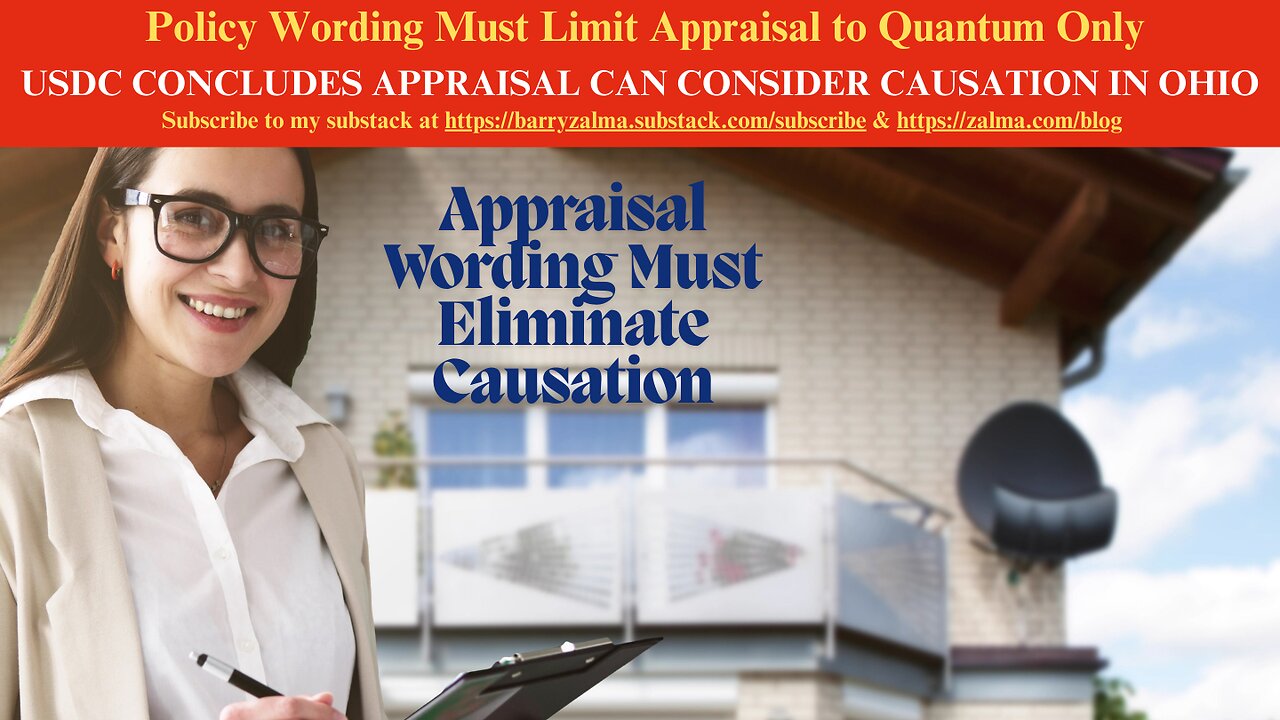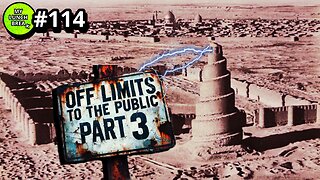Premium Only Content

Policy Wording Must Limit Appraisal to Quantum Only
USDC CONCLUDES APPRAISAL CAN CONSIDER CAUSATION IN OHIO
Post 4917
Defendant State Farm Fire and Casualty Company (“State Farm”) issued a homeowners insurance policy to Plaintiff Sharon Marie Rogers (“Rogers”). This policy was in effect on the loss date of March 25, 2023. State Farm determined the amount of loss to be $3,490.68, which was less than Rogers' deductible. Rogers retained a public adjuster, Insurance Adjusting Services West Penn; West Penn determined the amount of loss to be $214,871.20.
Plaintiff moved the Court to Compel Appraisal to resolve the dispute over the amount of loss and Stay Litigation. In Sharon Marie Rogers v. State Farm Fire and Casualty Co., No. 1:24-cv-148, United States District Court, S.D. Ohio, Western Division (October 11, 2024) the court resolved the dispute over the need for and scope of appraisal.
BACKGROUND
West Penn demanded appraisal on behalf of the insured. Trial counsel repeated the demand for appraisal. Rogers' Complaint against State Farm was filed the next day, to avoid the one year private limitation of action provision of the policy.
LAW & ANALYSIS
The purpose of an appraisal is to provide a plain, speedy, inexpensive and just determination of the extent of the loss. The appraisal provisions are an integral part of the body of each policy precisely the same as every other paragraph and are enforceable in Ohio as any other bargained-for contractual right. The parties agree that: a storm is a covered cause of loss; and the March 25, 2023 storm caused loss to Rogers' dwelling.
State Farm refused to honor Rogers' demand for appraisal for two reasons.
She did not comply with the condition precedent to provide to State Farm (at least ten days prior) “written, itemized documentation of a specific dispute as to the amount of the loss, identifying separately each item being disputed. Instead, Rogers only provided an estimate from a public adjuster, which references the global monetary estimate for the combined interior and exterior damages, and fails to specifically identify what items, if any, are being disputed.
State Farm contended that the amount of loss to be determined by appraisal includes only the pricing of the repairs it deems are covered, not the damages that Rogers, relying on West Penn's estimate, thinks should be covered.
Included as part of the demand for appraisal was its 197 line-item repair estimate. A Claim Specialist promptly responded on behalf of State Farm a week later. State Farm’s response was that items in the West Penn estimate included items that present a question of coverage under the policy and that appraisal cannot be used to resolve disputes regarding coverage provided by the contract. Therefore, appraisal would not be appropriate as outlined above; the appraisers and umpire have no authority to decide questions of coverage.
Nowhere did State Farm's agent state that Rogers' documentation was lacking under the policy. In fact, Claim Specialist McKenzie noted that West Penn's estimate “establishe[d] the dispute for this claim.” The USDC concluded that State Farm may not reverse course after litigation was filed.
THE LIMITATIONS IMPOSED ON APPRAISERS
Parties sometimes agree to a policy that prohibits appraisers from answering causation question when setting the amount of loss but when the appraisal clause says nothing about causation, Ohio courts' construction of amount of loss controls.
State Farm contended that the appraisal clause addresses causation in that it prohibits the appraisers (and the umpire) from deciding “any other questions of fact.”
The USDC disagreed.
State Farm, the drafter of the policy, included specific language about questions of “law” and questions of “coverage” if it had intended to include questions of “causation” it could (and should) have done so. The USDC concluded that to allow a catch-all phrase to incorporate causation is at odds with Ohio case law to date and, equally important, undermines the purpose behind appraisal.
CONCLUSION
Plaintiff's Motion to Compel Appraisalwas granted.
Defendant was ordered to proceed with the appraisal process as set forth in the policy, at the soonest time possible. The appraisals should separately calculate and identify disputed costs-to include both exterior and interior damage-so the Court can either include or exclude them once it has determined whether the policy provides coverage for them.
The civil action was stayed until a full appraisal occurs.
ZALMA OPINION
The history of the appraisal clause in fire and homeowners policies have limited the appraisers to establish only the quantum of a loss and were not authorized to determine coverage issues, without language in the policy stating so in the policy wording. The USDC in this case, applying Ohio law, requires that the policy wording must include language in the policy that the appraisers may not consider causation. The detailed report the court requires from the appraisers and umpire will allow it to make decisions about coverage for each item of value and loss the appraisers reach.
(c) 2024 Barry Zalma & ClaimSchool, Inc.
Please tell your friends and colleagues about this blog and the videos and let them subscribe to the blog and the videos.
Subscribe to my substack at https://barryzalma.substack.com/subscribe
Go to X @bzalma; Go to Newsbreak.com https://www.newsbreak.com/@c/1653419?s=01; Go to Barry Zalma videos at Rumble.com at https://rumble.com/account/content?type=all; Go to Barry Zalma on YouTube- https://www.youtube.com/channel/UCysiZklEtxZsSF9DfC0Expg
Go to the Insurance Claims Library – https://lnkd.in/gwEYk
-
 34:27
34:27
The Connect: With Johnny Mitchell
17 hours ago $13.72 earnedCan He Stop Them? Inside Trumps War On Mexican Drug Cartels & The New Era Of Mexican Organized Crime
35.3K18 -
 2:33:15
2:33:15
Tundra Tactical
10 hours ago $12.55 earnedLuis Valdes Of GOA Joins The Worlds Okayest Firearms Live Stream!!!
37.9K -
 1:03:41
1:03:41
Man in America
18 hours agoAre Trump & Musk the COUNTER-ELITES? w/ Derrick Broze
93.8K77 -
 3:45:08
3:45:08
DLDAfterDark
9 hours ago $11.85 earnedDLD Live! SHTF Handguns! Which Would You Choose?
50.8K4 -
 1:50:38
1:50:38
Mally_Mouse
12 hours agoSaturday Shenanigans!! - Let's Play: Mario Party Jamboree
60.1K -
 1:13:00
1:13:00
Patriots With Grit
16 hours agoWill Americans Rise Up? | Jeff Calhoun
49.9K13 -
 14:55
14:55
Exploring With Nug
16 hours ago $11.85 earnedWe Found Semi Truck Containers While Searching for Missing Man!
65K9 -
 27:57
27:57
MYLUNCHBREAK CHANNEL PAGE
1 day agoOff Limits to the Public - Pt 3
151K69 -
 38:07
38:07
Michael Franzese
16 hours agoLeaving Organized Crime and Uncovering Mob in Politics: Tudor Dixon and Michael Franzese
116K15 -
 2:42:54
2:42:54
Jewels Jones Live ®
2 days agoAMERICA IS BACK | A Political Rendezvous - Ep. 111
90.7K50